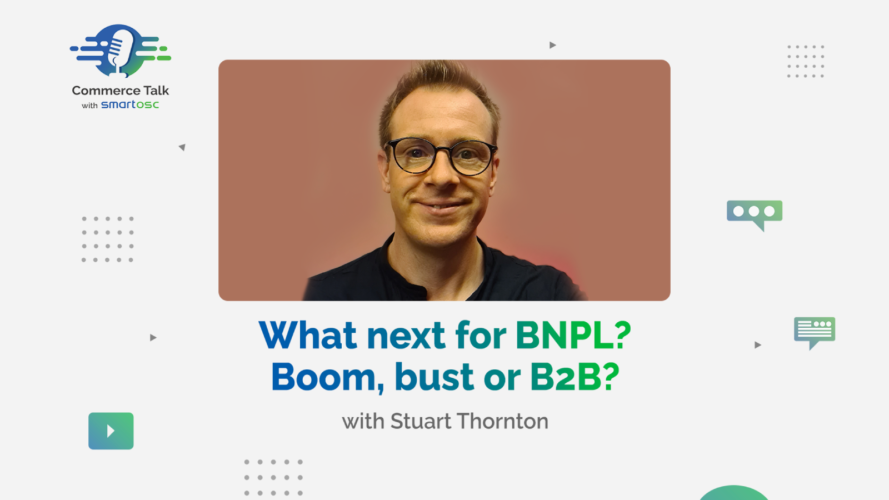What next for BNPL? Boom, bust or B2B?
Buy now, pay later, also known as BNPL, has taken off in a big way in recent years. The short-term financing method gives consumers the chance to make purchases and then pay for them in the future, usually on a fixed schedule. BNPL is most famous for its use in the business-to-consumer (B2C) sector, but increasingly, companies are exploring using the technology for business-to-business (B2B) transactions.
To discuss the sector’s past and present, we spoke to a bona fide BNPL expert: Stuart Thornton.

Stuart brings 25 years of experience in industries ranging from telecoms to payments across Europe, Asia and Australasia. Originally from the UK, Stuart has held leadership roles within both large enterprises and start-ups – including companies such as Verizon, Vodafone and Worldpay. Most recently, Stuart was Co-founder and CEO of hoolah, a buy-now-pay-later company that anticipated the growth in the sector to build first mover advantage across Asia.
As co-founder, CEO & chairman of hoolah, he led the development, strategy and growth of the business into markets such as Singapore, Malaysia, Hong Kong, Thailand and the Philippines. Stuart exited the business to Shopback in October 2021.
Prior to hoolah, he led the growth of Worldpay’s business across Asia Pacific. He was instrumental in setting the market strategy as well as scaling the team and winning some key notable clients, especially in the eCommerce and airlines verticals. Before moving into fintech in 2014, Stuart spent over 16 years in the telecommunications industry.
He now runs 6one- a consultancy, startup advisory and venture building company based out of Singapore and helping companies on commercial strategy for new opportunities.
You can subscribe and listen to the full episode on Spotify, Apple Podcasts, Google Podcasts, and elsewhere podcasts are found.
You can also check out this Q&A from the episode (edited for clarity and brevity).
Adrian: Detractors have said that BNPL is not much different from just racking up credit card debt and that it’s just dressed differently. So what is it about BNPL that means it isn’t just pushing pain down the river, as you’ve said before?
Stuart: From my perspective, having truly believed in the technology, the functionality behind it, and what it’s capable of achieving, I find some of the criticism a bitter pill to swallow but I do understand some of the context. When we were building the business, what we saw was this amazing opportunity to challenge the concept of credit card debt and help consumers to positively manage their payments over a short period of time, their personal cash flow, for want of a better term. The way in which we went to market was this concept called responsible affordability. We lived up to that in terms of how we were building the backend technology.
We were able to use top-notch technology to really manage who was able to use it, how often they were able to use it, and the value of what they were able to use it for. By doing so, you know, we were able to limit that debt position. That’s not necessarily the case for everybody in this space. A lot of it also comes down to the type of company that ultimately is offering the solution, risk management and attitudes towards growth. One of the bigger challenges is that there’s been a constant venture-backed focus on unachievable growth at all costs. That has contributed to slightly more negative outcomes because the business model does work if it’s done properly.
When you look at the difference between credit card debt and BNPL, credit cards work in a very different way. They focus on making money out of people’s unfortunate cash position and there’s the compound impact on that debt position. Whereas BNPL tends to look at it on more of a transactional level.
Adrian: Do you believe that BNPL can provide the same benefits it does in the B2C space to B2B? For example, increased basket sizes, higher order frequency, and more?
Stuart: Absolutely. First and foremost, you look at the B2B and specifically the SME space across Asia Pacific, it’s a massive industry that really hasn’t been engaged by technology to a significant amount. It’s very underserved by the cash flow solutions. You get a lot of back end solutions, you get a lot of SME financing. But a lot of these and credit in general, the banks don’t necessarily focus on this space and a little bit like the consumer space, they haven’t really engaged technology to try and help them engage and provide those services that a lot of SMEs require.
If you look at the specifics around the value proposition of what hoolah delivered to our customers, first and foremost, the concept of cash flow. This is the number one biggest issue that any company has big or small, they’re always trying to make sure that they can balance payments in and out, especially at the end of the month. And that’s rarely, rarely achieved. Always someone gets impacted as part of the supply chain, for example someone playing late and not getting their cash and, in difficult times, that becomes something that a lot of companies can really struggle with if they’re not being paid on time. That’s a little bit like the consumer side in terms of managing that personal cash flow of what comes in and what goes out.
Another thing that was really powerful around the BNPL consumer space is that it was almost an ecosystem or a marketplace environment. You were basically connecting a consumer to a merchant, or a brand. In the B2B space, I can’t count the number of times when running a business and I’ve tried to find who’s the best supplier for X, Y, and Z. The technology can bring together two companies who have similar needs to do business and also grease that wheel of doing business by offering some functionality.
You mentioned shopping cart value and two of the biggest things that came with the shopping cart value that we provided were around the conversion and loyalty engagement. In this kind of model, everyone wins, as the buyer manages the cash flow carefully over a short duration and the suppliers get the opportunity to grow the business. If you’re providing this value of cash flow management, you’ve got this wonderful opportunity to create loyalty engagement between those parties and get people coming back and using that more often.
Adrian: How does BNPL give B2B organisations more room to manoeuvre?
Stuart: As I mentioned, you get to the end of the month, and you’ve got all of a sudden two or three other ad hoc purchases and you’re having to try and find cash to maintain your positive credit position with suppliers, which can create a lot of stress. Especially if you’re a trading organisation where you’re living based on margin contribution to deliver cash flow. If you can spread those ad hoc costs, or perhaps growth and investment costs like buying more stock, and pay that off over a period of time, it gives you flexibility. You get to manage that outlay and also receive the benefit of the outlay quicker. Getting that margin contribution back into the business is a really positive place to be in for any company.
On the other side of things as a buyer, when you set payment deadlines and they’re missed, you have to invest in following up, and that becomes a painful expense monetarily and in terms of time. If you can get that money upfront you don’t have to worry about that at all. So if you just simply look at the two ends of the spectrum, you’re already creating a lot of flexibility and opportunity.
Adrian: How can BNPL provide SMEs credit access that they perhaps wouldn’t otherwise get?
Stuart: Looking at the market across Asia Pacific, you’ve got effectively SME financing, which tends to be a larger lump sum of working capital, cash or some sort of revolving facility that comes with an interest rate and tends to be a larger amount of money. If that cash is not optimally used within your business, you’re paying for cash that you don’t need, so that becomes quite ineffective or inefficient capital management. On the other side, you’ve got providers that are looking at working capital, or receivables financing. And again, it comes with a similar type model, but with some restrictions around access. It might be, for example, a platform that allows multiple providers to go and to lend that money but it can be very inefficient and inflexible around scaling down or up over a period of time, and especially getting alternative lenders to come into play because you’ve got your receivables locked away with one particular partner.
On the credit side, it’s interesting to see that credit tends to focus on more limited companies, but on the other side, banks tend to be challenged in this sort of environment around offering this kind of service to SMEs, because they won’t take that risk, because they use traditional, or tight credit models. So for companies that are trying to grow and scale responsibly, it becomes a real challenge because they don’t have access to credit functionality. Perhaps they might have some overdraft facilities, but overdraft tends to come with a significant cost and having that capital locked away in the business to back that overdraft up means there’s not a lot of flexibility.
If it’s not flexible, it’s expensive to and this is where I think BNPL can come in to manage that cash flow and give breathing room for companies to scale and digitize the business.
Adrian: Can BNPL be a way around the time-consuming credit approval process that B2Bs face?
Stuart: 100%. If you’re a sole trader of some description, time is your most valuable commodity, because you’re wearing 15 or 20 different hats to try and grow a business, or if you’re an SME you have a slightly larger team but time is still your most valuable commodity.
Trying to set up our first bank account, going through overdraft facilities, and trying to create partnerships with alternative lenders was an incredible struggle in terms of time and paperwork and compliance and governance. All of which are important, of course, when working with money, but it’s really difficult to do that.
Now if you have a model that helps you digitise to use existing data to allow either a transactional level analysis or assessment of risk, you’ve got a tremendous opportunity to solve this problem.
Adrian: Are there any particular types of B2B niches that you think lend themselves particularly well to BNPL?
Stuart: Absolutely. If I had a penny for every time one of our retailers with hoolah asked if they could use it for their own internal functionality, perhaps it would be even more valuable. With retailers, the first thing that comes to mind is you have to buy stock to grow your business and there’s always a limitation of cash flow. But to be honest, wherever there is a buyer and supplier, I think there is an opportunity for considerable digitization.
Adrian: Are there any features that of BNPL that you think would make bulk payments easier for B2B enterprises?
Stuart: I’ve spent a little bit of time researching the food industry and I think about as digital as they’ve got is using WhatsApp to communicate. It’s still heavily built on manually inputting invoices and sending bank transfers, so there’s a great opportunity to help companies. If you’re bringing a buyer and a supplier together, you’ve got this great opportunity to bring people together and as I’ve mentioned, some companies in some industries don’t necessarily have digitalization. If you’ve got this carrot of cash flow management, perhaps that’s also an opportunity to really drive digitization through the whole journey, from front-end and eCommerce transactions all the way up to your ERP or finance systems.
Adrian: How do you see the regulation question impacting the overall future of the sector?
Stuart: When we were building the hoolah business, regulation was always one thing that we were very, very focused on. Whichever country we were launching in, we did an awful lot of due diligence which was expensive to get the right sort of team around us to do that. But we knew that that was the most important thing as regulation sits there to protect people or entities. We had that responsible affordability and responsible spending mindset and marketing position, and product structure, so it was absolutely important that we also educated the market and the regulators about what could be done in that space. Often the problem when you create new technology and have new people coming in is sometimes they have different motives or ambitions or don’t necessarily have the same sort of compliance or due diligence mindset. That’s where lack of regulation starts to cause problems.
The problem with regulation is when it starts to impinge on innovation, and perhaps it’s not necessarily educated correctly about what’s possible, and where the restrictions have to sit. If you apply the same mentality to existing products in existing structures, that’s where it starts to cause some pain and perhaps a controversial problem.
I’ve heard some thoughts around regulation in Australia, passing on surcharges, for example, and it kind of goes against the whole concept of what BNPL is. You give this opportunity for consumers to go and use the service and then you charge them for it, you’re almost taking from Peter and giving to Paul, it doesn’t make sense. Ultimately, it’s an investment for the merchants to get access to that, it’s not like a credit card, where it just becomes a functional payment model, this is actually delivering a lot more value, assuming that this service provider is able to create that value, and the merchant can see that value of what they’re creating.
Adrian: Do you have some top tips for any B2B company considering BNPL as part of their suite of payment options?
Stuart: If cash flow is important to you, and it is for 99% of us, trying to remove manual reconciliation and management of credit terms and credit management, perhaps of payments, will be beneficial. If you want to help grow the business through digitization, BNPL is a fantastic opportunity to try this. It takes companies to create a flywheel effect and the more that you have a buyer and a supplier using it, the more that you’ll start to see that market take off and see the benefits created.
Adrian: On the other side, what would you advise a BNPL company looking to get into the B2B space?
Stuart: First of all, the consumer BNPL companies are fundamentally quite different. A lot of consumer data risk is about the emotion and the affordability of payments at that moment in time. Whereas B2B risk management tends to be around the people that are in the company, the cash flow, the balance sheets, profit and loss, compliance and the BNPL risk management infrastructure isn’t set up to support that. But there are some fundamental benefits that are very similar for the BNPL and B2B space.
I remember three big tips someone gave to me at the beginning of hoolah. Number one, risk is ultimately the priority. It comes down to focusing on the health of your business, rather than growth. You have to manage risk carefully and conservatively to create value in the market, both for customers and for the health of the company, and as a service provider.
Number two is disciplined growth. Careful growth, rather than sort of venture growth is important and it can be achieved.
And then ultimately, it’s about managing cash flow. That’s the most important thing, especially in the B2B space where tickets are bigger and it’s important to get access to the right lending models.


